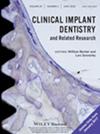Horizontal ridge augmentation with particulate cortico-cancellous freeze-dried bone allograft alone or combined with injectable-platelet rich fibrin in a randomized clinical trial
Abstract
Objectives
The objective of this study is to assess the effectiveness of horizontal ridge augmentation using FDBA in combination with injectable-platelet rich fibrin (i-PRF) versus FDBA alone. To fulfill this aim, the radiographic and histomorphometric outcomes are compared.
Method
The study involved 41 patients who had horizontal alveolar ridge defects categorized as either B (2.5–7 mm) or C (0–2.5 mm). The control group received FDBA alone (n = 20), while the test group received FDBA in combination with i-PRF (n = 21). The horizontal dimensions of the alveolar ridge were measured at 0, 2, 4, and 6 mm from the bone crest using CBCT before and 6 months after alveolar ridge augmentation. In the second-stage surgery, 24 biopsies were taken from the augmented bone — 13 from the control group and 11 from the test group, and were examined histologically and histomorphometrically. The data were analyzed using Pearson correlation coefficient, chi-square, paired-t, and two-sample t tests.
Results
There was no significant difference (p > 0.05) in the increase of mean ridge width between the test group and the control group after 6 months at distances of 0, 2, 4, and 6 mm from the crest, with differences of −0.28, 0.12, 0.52, and 1.04 mm, respectively. However, the amount of newly formed bone and material residues was significantly higher in the FDBA + i-PRF group compared to the FDBA alone group (45.01% and 13.06% vs 54.03% and 8.48%, respectively). There was no significant difference in the amount of soft tissue between the two groups (41.02% and 37.5%, p > 0.05).
Conclusion
The study found that there was no statistically significant difference in the increase of horizontal ridge width between the FDBA + i-PRF group and the FDBA group. However, the histomorphometric analysis revealed that the FDBA + i-PRF group had a higher proportion of newly formed bone, less connective tissue, and fewer residual particles. This suggests a superior quality of bone formation compared to the FDBA group.

 求助内容:
求助内容: 应助结果提醒方式:
应助结果提醒方式:


